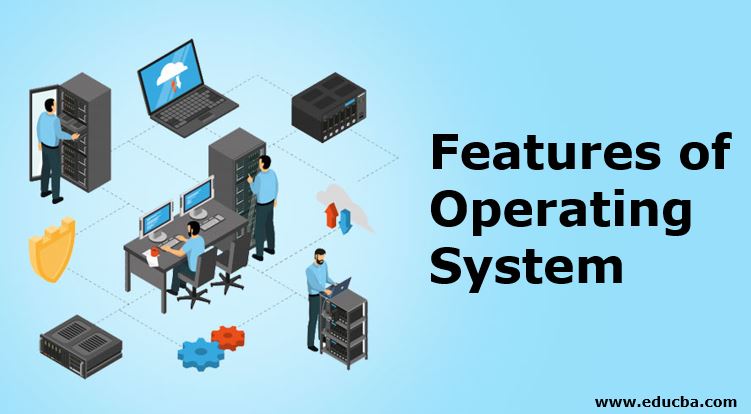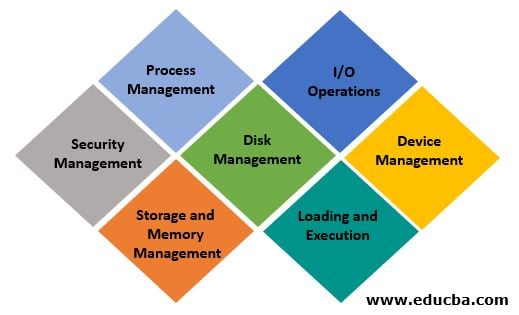Updated November 30, 2023

Overview of Operating System
All application such as games, MS Office, and Firefox requires a suitable environment to execute and perform their task. The operating system helps the user interact without knowing to work with the computer language. It is not feasible for anyone to use any smartphones or computers without deploying the operating system. Having at least one operating system to execute the programs and perform the task is mandatory. So in simple, the operating system is defined as the software that acts as a line between computer hardware and end-user for easy interaction to complete the task effectively.
Various Features of the Operating System
There is a wide range of notable features in the operating system, which is developing day by day. The growth of the OS is admirable because it has evolved from being developed in 1950 to handle storage tapes to now functioning as an interface that provides a visual treat to the end-user with brilliant colors.
Given below are the features of the operating system:
1. Security Management
The information and confidential data stored in the system are protected by the operating system, which blocks the system by giving strong authorized keys to the user securing the system from malware attacks. The operating system acts as supervisor mode and gives the system a strongly protected firewall. OS handle and rectify the errors as soon as possible without any difficulty.
2. Process Management
The operating system effectively manages the execution of the program without any overlapping or time delay. Process management supports OS in developing and eliminating processes and provides a mechanism for communication and synchronization within multiple processes.
3. Storage and Memory Management
OS performs memory management and virtual memory multitasking. The need for memory management in OS is to allocate and de-allocate memory space to process in demand of resources, or if they are running out of memory, that leads to alerts called file system and disk space is high or full. So it is advisable to view and back up the memory and storage devices periodically. The system has many storage hierarchies, like primary, secondary, and cache storage. The running process should save pseudocode and data in the Cache, allowing it to refer to them in case of any issues. The operating system can do resource allocation and prevent the system from overloading.
4. Disk Management
OS permits disk access to manage files systems, file system device drivers, and related activities of files like retrieval, naming, sharing, storage, and protection of files.
5. I/O Operations
OS can effectively handle I/O operations to hide the peculiar behavior of hardware from the end user.
6. Loading and Execution
The command interpretation is made to interpret the given commands and make the resources act on the system by processing the commands. The group of processors that don’t share a memory or hardware device is called a distributed system, where the processor interacts with another device throughout the network. OS coordinates and assigns the interpreters, compilers, and other software resources for the different uses of the computer system. Booting is one of the essential features of the operating system that makes the computer’s OS start and load the computer to work. It is also termed as loading and execution of the computer system.
7. Device Management
An operating system controls the device and printer by permitting a correct flow. Disk management tracks all hardware connected to the system and the resource utilized by different jobs and users. It is one of the responsible for the I/O controller.
Types of Operating Systems
The most common operating system types used popularly are Microsoft Windows, Linux, Apple macOS, Google’s Android, and Apple’s iOS.
1. Batch Operating System
The batch operating system is a very lengthy and time-saving process. To speed up the same process, a job with the same requirements is combined and executed as a group. The batch operating system user doesn’t directly interact with the computer. Each user has to schedule the job offline, such as punch card, and submit it to the computer.
2. Multi-tasking Operating System
A multi-tasking operating system enables people at different terminals to access a single computer system simultaneously. Distributing the CPU’s processor time among multiple users is known as time-sharing.
3. Real-time Operating System
The military and Space software system is a real-time operating system with a minimum response time for fetching and executing the input commands.
4. Distributed Operating System
The distributed operating system is similar to the time-sharing system, where the distributed system uses many processors located in various locations to provide fast computing to users.
5. Network Operating System
A networking operating system executes on a server that can serve and manages the data, groups, user, security, application, and other networking functions.
6. Mobile Operating System
Developers design the mobile operating system to power tablets, wearable devices, and smartphones. Some smartphone OS includes BlackBerry, Web, watchOS, Android, and iOS.
OS allows the user to hide the hardware information by building an abstraction, and it is easy to use with GUI. It is a platform for easy deployment of applications of programs. It makes sure that the computer system is comfortable to use. But if any faults in OS, it leads to data loss. It is essential to manage it with high efficacy. It is expensive for a small firm but offers many features.
The kernel is a significant operating system component that manages the communication between software and hardware. People commonly use Microkernels and Monolithic kernels for communication purposes. The unique functions of the operating system include process, device, I/O, files, and memory management. The essential types of operating systems are batch, multitasking, real-time, network, and mobile operating systems.
Recommended Articles
This has been a guide to Features of Operating System. Here we discuss the introduction, various features, and types of operating systems. You may also have a look at the following articles to learn more –


